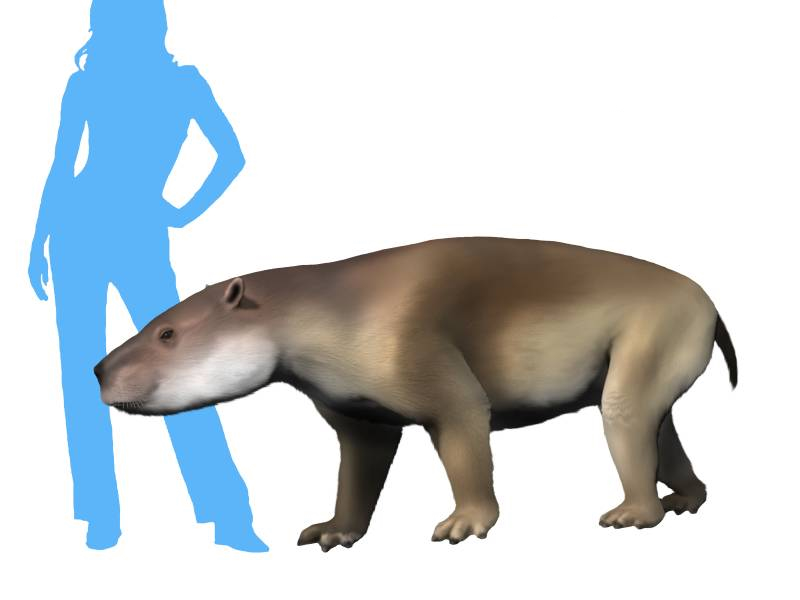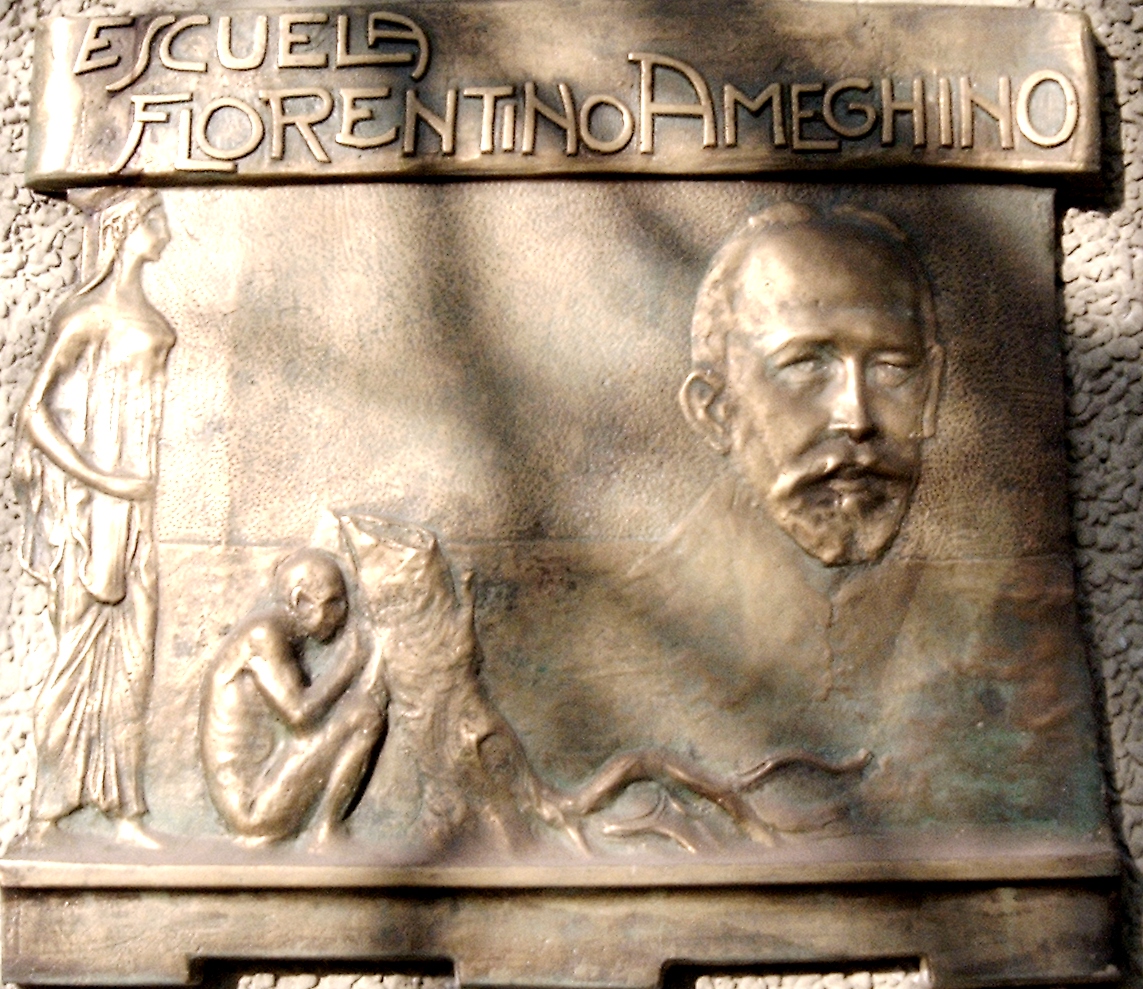|
Pyrotheres
Pyrotheria is an order of extinct meridiungulate mammals. These mastodon-like ungulates include the genera ''Baguatherium'', ''Carolozittelia'', ''Colombitherium'', ''Griphodon'', ''Propyrotherium'', ''Proticia'', and ''Pyrotherium''. They had the appearance of large, digitigrade, tapir-like mammals with relatively short, slender limbs and five-toed feet with broad, flat phalanges. Their fossils are restricted to Paleocene through Oligocene deposits of Brazil, Peru and Argentina. Some experts place the clade Xenungulata (which contains several genera, including ''Carodnia'') within Pyrotheria, even when dentition, although bilophodont in both orders, is very different. For most scholars, the two orders remain separated. The dentition is complete with strong, procumbent, chisel-shaped incisors, strong sharp-pointed canines, and low-crowned cheek teeth with bilophodont molars. The affinities of the Xenungulata remain uncertain. Affinities with the Dinocerata are strongly supported ... [...More Info...] [...Related Items...] OR: [Wikipedia] [Google] [Baidu] |
Pyrotherium
''Pyrotherium'' ('fire beast') is an extinct genus of South American ungulate, of the order Pyrotheria, that lived in what is now Argentina and Bolivia, during the Late Oligocene.''Pyrotherium'' at .org It was named ''Pyrotherium'' because the first specimens were excavated from an ancient volcanic ash deposit. Fossils of the genus have been found in the and s of Argentina and the |
Meridiungulata
South American native ungulates, commonly abbreviated as SANUs, are extinct ungulate-like mammals of controversial affinities that were indigenous to South America prior to the Great American Biotic Interchange. They comprise five major groups conventionally ranked as orders—Astrapotheria, Litopterna, Notoungulata, Pyrotheria, and Xenungulata—as well as some other taxa, such as Didolodontidae and Kollpaniidae. It has been proposed that some or all of the members of this group form a clade, named Meridiungulata, though the relationships of South American ungulates remain largely unresolved. The two largest groups of South American ungulates, the notoungulates and the litopterns, were the only groups to persist beyond the mid Miocene. Only a few of the largest species of notoungulates and litopterns survived until the end-Pleistocene extinctions. Though most SANUs lived in South America, astrapotheres and litopterns are known from Eocene aged deposits in the Antarctic Peninsu ... [...More Info...] [...Related Items...] OR: [Wikipedia] [Google] [Baidu] |
Xenungulata
Xenungulata ("strange ungulates") is an order of extinct and primitive South American hoofed mammals that lived from the Late Paleocene to Early Eocene (Itaboraian to Casamayoran in the SALMA classification). Fossils of the order are known from deposits in Brazil, Argentina, Peru, and Colombia. The best known member of this enigmatic order is the genus ''Carodnia'', a tapir-like and -sized animal with a gait similar to living African elephants. Description Xenungulates are characterized by bilophodont M1–2 and M1–2, similar to pyrotheres, and complex lophate third molars, similar to uintatheres. Though other relationships, to arctocyonids for example, have been suggested, no proofs thereof have been found. The foot bones of xenungulates were short and robust and their digits terminated in broad, flat, and unfissured hoof-like unguals, quite unlike any other meridiungulates. The discovery of ''Etayoa'' in Colombia made it clear that xenungulates are distinct from ot ... [...More Info...] [...Related Items...] OR: [Wikipedia] [Google] [Baidu] |
Ungulates
Ungulates ( ) are members of the diverse clade Ungulata which primarily consists of large mammals with hooves. These include odd-toed ungulates such as horses, rhinoceroses, and tapirs; and even-toed ungulates such as cattle, pigs, giraffes, camels, sheep, deer, and hippopotamuses. Cetaceans such as whales, dolphins, and porpoises are also classified as even-toed ungulates, although they do not have hooves. Most terrestrial ungulates use the hoofed tips of their toes to support their body weight while standing or moving. The term means, roughly, "being hoofed" or "hoofed animal". As a descriptive term, "ungulate" normally excludes cetaceans as they do not possess most of the typical morphological characteristics of other ungulates, but recent discoveries indicate that they were also descended from early artiodactyls. Ungulates are typically herbivorous and many employ specialized gut bacteria to allow them to digest cellulose. Some modern species, such as pigs, are omnivorous, ... [...More Info...] [...Related Items...] OR: [Wikipedia] [Google] [Baidu] |
Colombitherium
''Colombitherium'' is an extinct mammal from Eocene, Late Eocene Colombia. It has originally been assigned to the order Pyrotheria and the family Colombitheriidae, although a later detailed analysis of the fossil questions that classification. A fossil jawbone of approximately length of ''Colombitherium'' has been found by Texas Petroleum in 1945, in the Upper Eocene strata of the middle Gualanday Group in the department of Tolima Department, Tolima, Cordillera Central (Colombia), Central Ranges of the Colombian Andes. Etymology The genus ''Colombitherium'' means "Beast from Colombia". The species epithet ''tolimense'' refers to the departments of Colombia, department of Tolima Department, Tolima, where the type species has been found.Billet et al., 2010, p.319 Description The genus is only known from a single jawbone with some teeth, found by Texas Petroleum in 1945, a specimen approximately in length, recovered from the Late Eocene middle part of the Gualanday Group on th ... [...More Info...] [...Related Items...] OR: [Wikipedia] [Google] [Baidu] |
Baguatherium
''Baguatherium'' is an extinct genus of herbivorous mammal, belonging to the order Pyrotheria. It lived during the Early Oligocene, and its fossilized remains were discovered in Peru. Description Although the fossils known are very partial (a maxilla, a left femur, isolated molars, they allow a comparison with those of similar animals better known, such as ''Pyrotherium'', and it can be hypothesized that ''Baguatherium'' was a large animal with heavy forms, similar to early proboscideans or modern tapirs. Compared to ''Pyrotherium'', ''Baguatherium'' possessed a slightly wider palate and the ridges on the molariform teeth were less oblique. A notable lingual crest connecting the posterior and anterior crests of those teeth was also present. The nasal bones, as in ''Pyrotherium'', were set back and indicate the presence of a proboscis. Classification ''Baguatherium jaureguii'' was first described in 2006, based on fossilized remains found near Bagua Grande, in the Departmen ... [...More Info...] [...Related Items...] OR: [Wikipedia] [Google] [Baidu] |
Carodnia
''Carodnia'' is an extinct genus of South American ungulate known from the Early Eocene of Brazil, Argentina, and Peru. ''Carodnia'' is placed in the order ''Xenungulata'' together with ''Etayoa'' and '' Notoetayoa''. ''Carodnia'' is the largest mammal known from the Eocene of South America. It was heavily built and had large canines and cheek teeth with a crested pattern like the uintatheres to which it can be related. In life, it would have been a tapir-sized animal. It bore strong resemblances to dinoceratans, although without tusks or ossicones. Description Simpson noted that ''Carodnia'' resembles the primitive uintathere '' Probathyopsis''. Although Paula Couto also made the same favorable comparison, he placed ''Carodnia'' in the new order Xenungulata. concluded that ''Probathyopsis'' shares several dental characteristics with ''Carodnia'', but that in the latter the anterior dentition of is more reduced, the second lower and upper premolars are enlarged and pointe ... [...More Info...] [...Related Items...] OR: [Wikipedia] [Google] [Baidu] |
Griphodon
''Griphodon'' is an extinct genus of mammals, belonging to the order Pyrotheria. It lived during the Middle Eocene, in what is now Peru. Description All that is known about this animal is a fragment of a mandible complete with teeth. Its teeth were two-crested, slightly more transversal than in other genera such as '' Carolozittelia'', but there are indications of the presence of a longitudinal crest, and even, in the third premolar, of a complete crest, not found in ''Pyrotherium''. Classification ''Griphodon peruvianus'' was first described in 1924 by Anthony, who considered it to be a Perissodactyl. The fragmentary fossil was found near Chicoca, along the Huallaga River. Subsequently the genus was considered a basal member of the Pyrotheres, a mysterious clade of heavy-shaped mammals from the Early Cenozoic of South America, of uncertain affinities. Other fossils attributed to ''Griphodon'' were later found near Contamana in the Loreto Province of Peru , image_f ... [...More Info...] [...Related Items...] OR: [Wikipedia] [Google] [Baidu] |
Peru
, image_flag = Flag of Peru.svg , image_coat = Escudo nacional del Perú.svg , other_symbol = Great Seal of the State , other_symbol_type = Seal (emblem), National seal , national_motto = "Firm and Happy for the Union" , national_anthem = "National Anthem of Peru" , march = "March of Flags" , image_map = PER orthographic.svg , map_caption = , image_map2 = , capital = Lima , coordinates = , largest_city = capital , official_languages = Peruvian Spanish, Spanish , languages_type = Co-official languages , languages = , ethnic_groups = , ethnic_groups_year = 2017 , demonym = Peruvians, Peruvian , government_type = Unitary state, Unitary Semi-presidential system, semi-presidential republic , leader_title1 = President of Peru, President ... [...More Info...] [...Related Items...] OR: [Wikipedia] [Google] [Baidu] |
Argentina
Argentina (), officially the Argentine Republic ( es, link=no, República Argentina), is a country in the southern half of South America. Argentina covers an area of , making it the second-largest country in South America after Brazil, the fourth-largest country in the Americas, and the eighth-largest country in the world. It shares the bulk of the Southern Cone with Chile to the west, and is also bordered by Bolivia and Paraguay to the north, Brazil to the northeast, Uruguay and the South Atlantic Ocean to the east, and the Drake Passage to the south. Argentina is a federal state subdivided into twenty-three provinces, and one autonomous city, which is the federal capital and largest city of the nation, Buenos Aires. The provinces and the capital have their own constitutions, but exist under a federal system. Argentina claims sovereignty over the Falkland Islands, South Georgia and the South Sandwich Islands, and a part of Antarctica. The earliest recorded human prese ... [...More Info...] [...Related Items...] OR: [Wikipedia] [Google] [Baidu] |
Florentino Ameghino
Florentino Ameghino (born Giovanni Battista Fiorino Giuseppe Ameghino September 19, 1853 – August 6, 1911) was an Argentine naturalist, paleontologist, anthropologist and zoologist, whose fossil discoveries on the Argentine Pampas, especially on Patagonia, rank with those made in the western United States during the late 19th century. Along with his two brothers –Carlos and Juan– Florentino Ameghino was one of the most important founding figures in South American paleontology. From 1887 until his death, Ameghino was passionately devoted to the study of fossil mammals from Patagonia, with the valuable support of his brother Carlos Ameghino (1865–1936) who, between 1887 and 1902, made 14 trips to that region, where he discovered and collected numerous fossil faunas and made important stratigraphic observations which helped to support his journal Ameghiniana. Biography Ameghino was born on September 19, 1853 in Tessi, an hamlet of Moneglia, a municipality of Liguria in Ita ... [...More Info...] [...Related Items...] OR: [Wikipedia] [Google] [Baidu] |
Oligocene
The Oligocene ( ) is a geologic epoch of the Paleogene Period and extends from about 33.9 million to 23 million years before the present ( to ). As with other older geologic periods, the rock beds that define the epoch are well identified but the exact dates of the start and end of the epoch are slightly uncertain. The name Oligocene was coined in 1854 by the German paleontologist Heinrich Ernst Beyrich from his studies of marine beds in Belgium and Germany. The name comes from the Ancient Greek (''olígos'', "few") and (''kainós'', "new"), and refers to the sparsity of extant forms of molluscs. The Oligocene is preceded by the Eocene Epoch and is followed by the Miocene Epoch. The Oligocene is the third and final epoch of the Paleogene Period. The Oligocene is often considered an important time of transition, a link between the archaic world of the tropical Eocene and the more modern ecosystems of the Miocene. Major changes during the Oligocene included a global expansion o ... [...More Info...] [...Related Items...] OR: [Wikipedia] [Google] [Baidu] |



